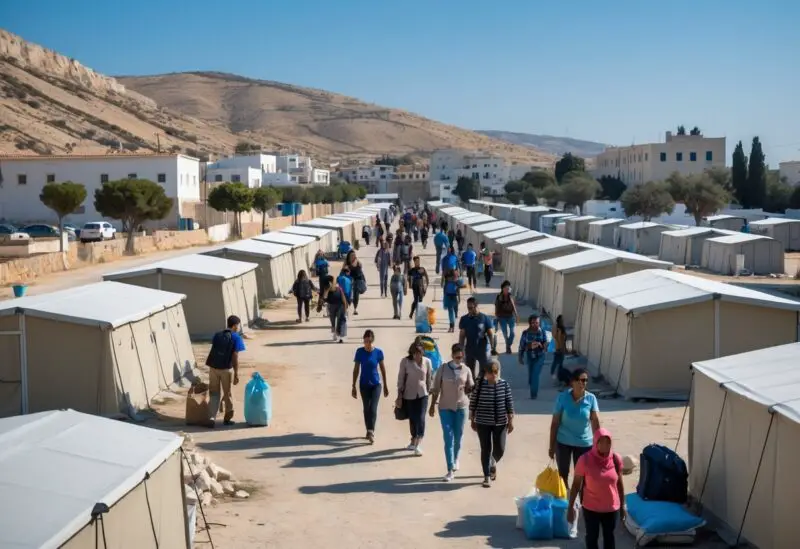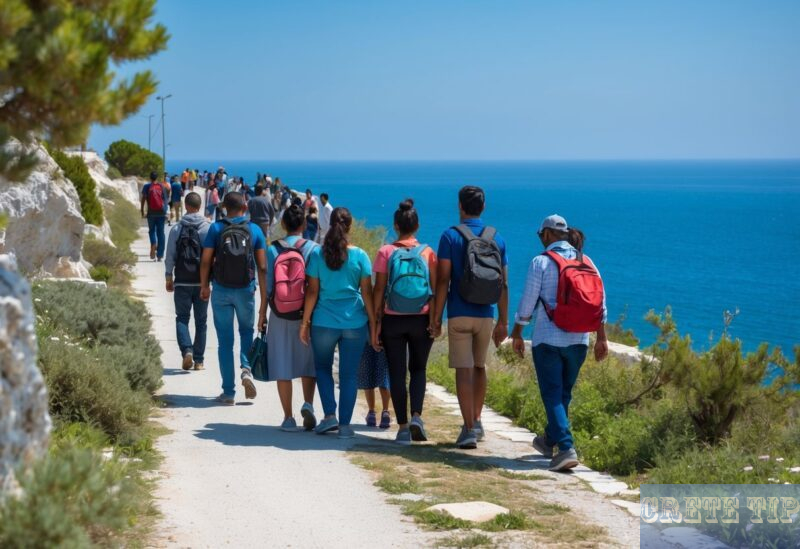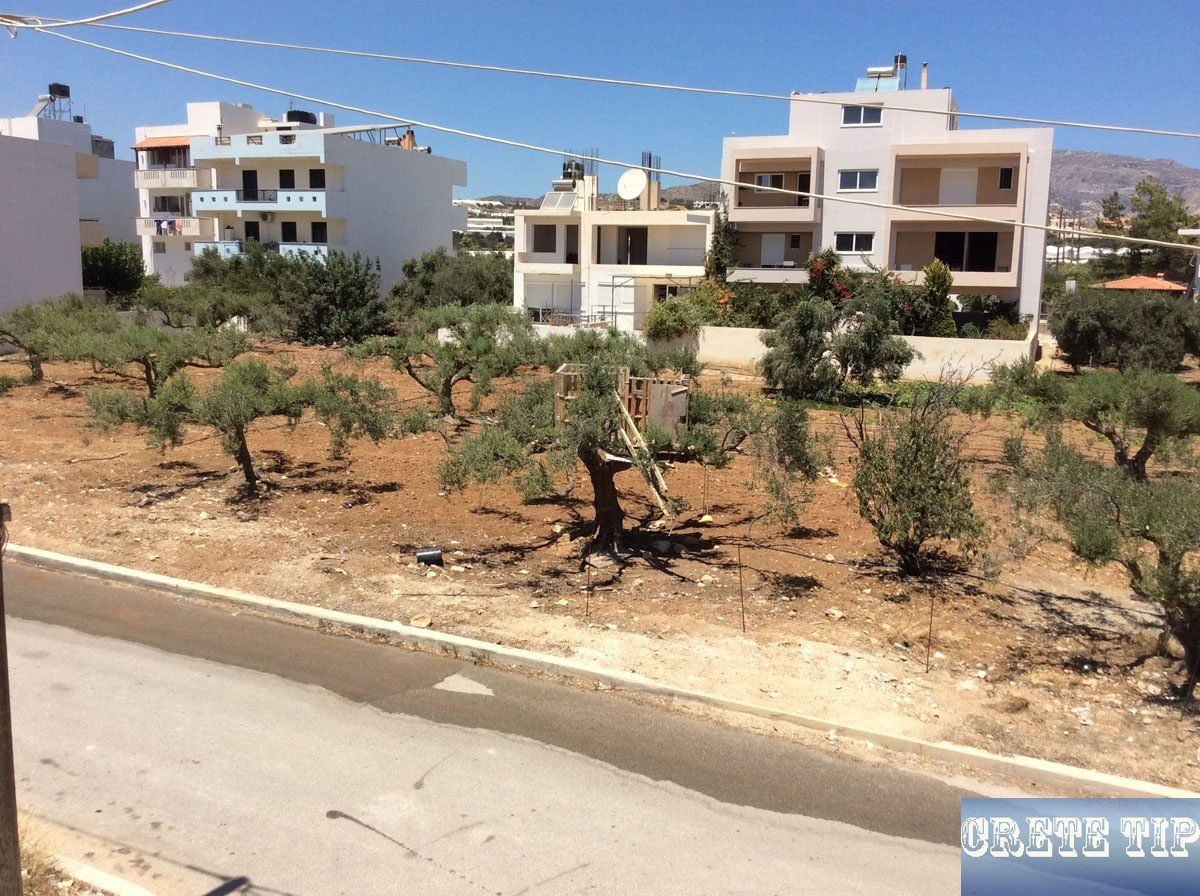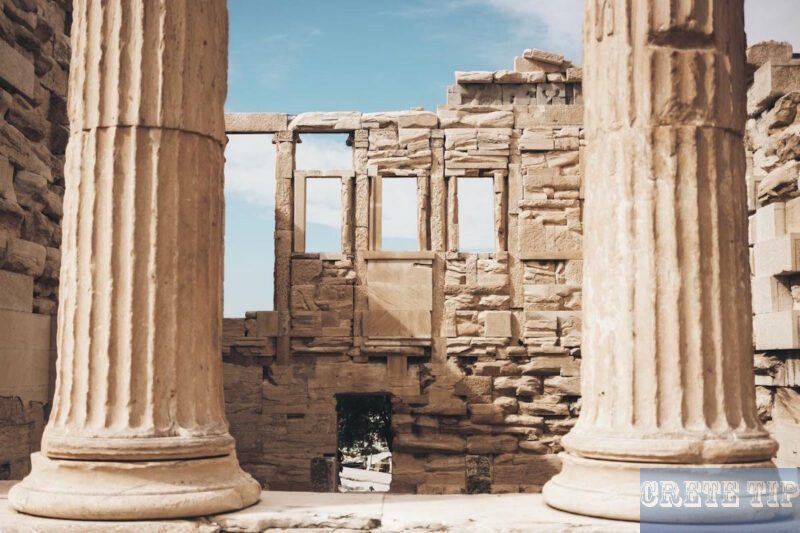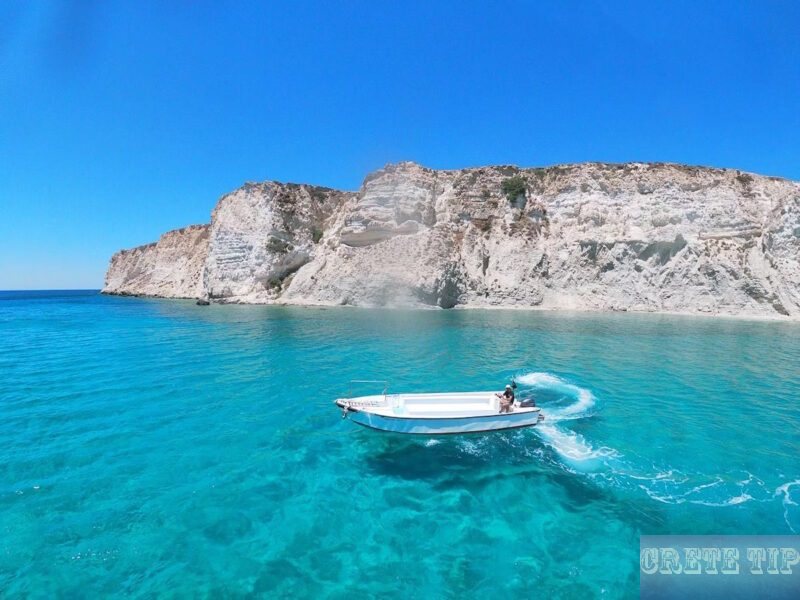Suspension of asylum applications, drastic cuts in benefits for asylum seekers, and reception centers planned on Crete, while Haftar’s soldiers are apparently loading migrants onto boats bound for Crete. However, the suspension of asylum applications violates international law, and there are also touching stories among the rescued migrants.
Suspension of asylum applications and reception centers in Crete
The Greek government plans to set up a permanent closed migrant reception centre in Crete. Kastelli in Heraklion seems to be the frontrunner for the site, though a second centre could pop up if needed.
Officials from Crete and the Ministry of Migration and Asylum will meet soon to hash out the details. They’re still ironing things out, but that’s the gist for now.
The government introduced a legal measure to temporarily stop asylum requests from people arriving illegally by sea from North Africa. For three months, anyone arriving this way will be sent straight back to their home country—no formal registration, no waiting around.
They’re hoping this will cut down on unauthorized arrivals and show they’re serious about controlling migration from North Africa. The approach feels pretty strict, honestly.
Building closed reception centres is part of a larger push to manage and contain irregular migration. Migrants who come in unlawfully will get detained in these centres while authorities figure out what to do with their cases.
Key Points on New Reception Centres and Policies
Topic |
Details |
|---|---|
Location |
Primary site likely at Kastelli, Heraklion; possibility of a second centre in Crete |
Type of Facility |
Permanent closed structure to hold migrants entering illegally |
Policy on Asylum Requests |
Three-month suspension on accepting new asylum claims from migrants arriving by sea from North Africa |
Return Procedures |
Immediate return of these migrants without registration, sending them back to their origin countries |
Government Intent |
To curb irregular migration, increase border security, and send a clear deterrent message to traffickers |
Crete’s been feeling the squeeze from rising migration numbers lately. Municipalities like Chania have really struggled with temporary migrant accommodation.
The island’s existing Reception and Identification Centres (ΚΥΤ) process migrants who enter without permits. These new closed centres? They’re a shift towards more controlled and secure facilities, for sure.
Impact on Local Communities
Local authorities, especially in Chania, have managed short-term shelters for migrants. The new closed centres hope to centralize and streamline things a bit.
That should lighten the load on local communities and cut down on bureaucracy. A dedicated space for detention and identification might actually help.
Current Migration Management System
- Reception Centres (ΚΥΤ): First stop for migrant registration and processing.
- Short-Term Shelters: Found in places like Chania, Rethymno, and Rhodes for temporary housing during registration.
- Closed Centres: New facilities planned to detain migrants who enter illegally while their status gets sorted out.
The Policy Framework
The new law takes a hard line on irregular migration from North Africa. It suspends the right to submit asylum petitions for a set time, aiming to cut down sea arrivals and beef up border control.
Closed reception centres in Crete will operate under these new rules. Migrants will stay there while their legal process plays out or until they’re sent back home.
The government keeps repeating that these centres are part of a broader migration plan and are meant to send a message to traffickers using Crete as a route into Europe.
Summary Table of Migration Flow Control in Crete
Element |
Description |
|---|---|
Reception Points |
ΚΥΤ facilities conducting migrant registration |
Temporary Shelters |
Short-term accommodation in regions such as Chania |
New Closed Centres |
Permanent closed centres for detention and controlled processing |
Legal Changes |
Asylum requests suspended for three months for sea arrivals from North Africa |
Enforcement |
Immediate repatriation without registration for those arriving illegally through maritime routes |
Sharp Reduction in Benefits for Asylum Seekers and Five-Year Prison Sentence if Application Is Rejected
Minister of Migration and Asylum Thanos Plevris has rolled out strict new measures for migrants and asylum seekers in Greece. The focus is on slashing financial support and welfare for those applying for asylum, with a full review of all benefits for foreign nationals underway.
The main goal is to cut back on subsidies for migrants. Right now, asylum seekers get a daily cash allowance and multiple meal options, plus a roof over their heads.
Plevris says that’s changing. He called the current system too comfortable—almost like a hotel, in his words. Apparently, those seeking asylum shouldn’t expect so much support anymore.
Instead, the government wants asylum seekers who want to stay in Greece to find work and not just lean on state aid. It’s a tough message, but that’s the direction things are heading.
Key points of the policy include:
- Major reduction in all financial benefits for asylum seekers.
- No more multiple meal choices in accommodation centres; menus will be revised.
- Daily cash allowances will go only to those working or with official refugee status.
- If an asylum application gets rejected, staying in the country becomes a criminal offence.
- Anyone who stays after rejection faces a five-year prison sentence—no parole.
- The only way out for rejected applicants is to cooperate and agree to return home.
On medical checks, Plevris said migrants who refuse age verification tests will be treated as adults. The government hopes this will stop people from abusing the system by lying about their age.
They’ve also noticed that about half of arrivals don’t get asylum, and 60% of applicants are men aged 18 to 30. Plevris stressed that the government won’t tolerate large-scale irregular entries, especially from Libya, where things are politically messy and there aren’t proper migrant centres.
The government wants a stricter, more controlled system that still follows international law. They’re trying to cut incentives for migrants to stay illegally and push for smoother returns. It’s a definite shift towards a tougher stance on immigration and asylum in Greece.
The Suspension of Asylum Requests Violates International Law
Suspending asylum applications goes against international law, plain and simple. That principle isn’t really up for debate—it contradicts commitments under agreements like the Geneva Convention.
No authority can legally block people from making asylum claims. Doing so denies them the right to seek protection from harm or persecution.
The Geneva Convention says you can’t just pause or interrupt the asylum process. Courts have already ruled on this.
Previous attempts to suspend asylum requests landed in court. The European Court of Justice made it clear: suspending asylum procedures is illegal, no matter the political or social pressure.
Governments sometimes float the idea of halting asylum claims during migration surges or tense times. But that’s not a legal excuse. The right to request asylum is fundamental—temporary measures can’t override it.
There’s also an ethical side. Suspending asylum applications puts vulnerable people at greater risk. It cuts them off from the international protection system that’s supposed to keep them safe.
Countries dealing with higher arrivals need better systems for registration and processing, not a blanket stop on claims. Preparation and effective management are key to handling migration within the law.
The international community keeps stressing that blocking asylum procedures undermines the rule of law and violates standards. Any country that tries it will face criticism and legal trouble.
Key points regarding the prohibition of suspending asylum claims:
Factor |
Explanation |
|---|---|
Legal Obligation |
States are bound by treaties like the Geneva Convention to allow asylum applications. |
Judicial Rulings |
Courts in Europe have ruled suspensions of asylum applications illegal. |
Human Rights Impact |
Suspension violates the right to protection and risks endangering displaced persons. |
Management Need |
Governments should focus on improving systems, not halting claims. |
Political Pressure |
Migration challenges do not justify ignoring international laws. |
Haftar’s soldiers load migrants onto boats bound for Crete
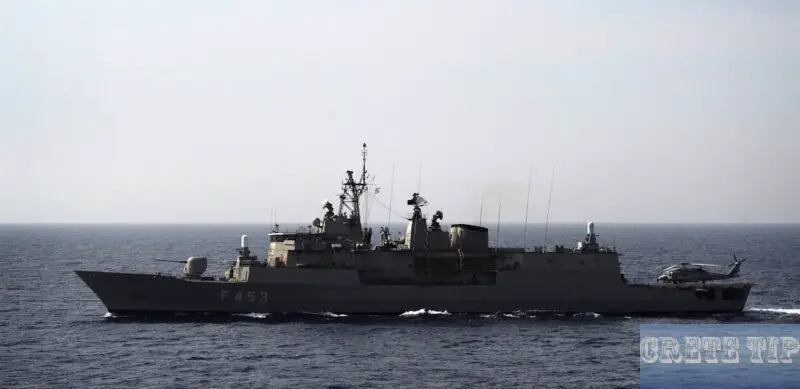
Greek authorities say they’ve got clear evidence linking the recent surge in migrant flows from Libya to Crete to the forces loyal to General Khalifa Haftar. Surveillance—everything from frigates’ high-tech optics and drones buzzing the Libyan coast to sharp satellite shots—shows a pretty well-oiled operation.
Migrants, mostly from African countries, make their way to Libya with their eyes set on the port of Tobruk. When they get there, uniformed personnel connected to Haftar’s security forces step in and start directing them in a pretty coordinated way.
The migrants move in convoys, guided by these uniformed agents, to two specific spots inside the port. It’s not free—each step comes with a price, making the whole thing feel a bit transactional, honestly.
Once everyone’s gathered, the migrants split into groups and wait their turn to board either small boats or larger vessels that traffickers operate. These boats head north, aiming for Gavdos and the southern shores of Crete.
The uniformed forces stick with the migrants the whole way, from their arrival in Tobruk right up to the moment they board the boats. It’s a hands-on approach, not just a quick handoff.
The Greek military keeps a close watch about 24 nautical miles offshore, right at the edge of the contiguous zone. Two frigates, a support vessel, and coast guard emergency ships patrol around the clock, keeping tabs on what’s happening along the Libyan coastline.
Apparently, Libyan eastern authorities have even asked the Greek forces to keep their distance at that 24-mile mark. That’s a pretty specific request, isn’t it?
Key Elements of the Migrant Transfer Operation |
|
|---|---|
Main Port of Departure |
Tobruk |
Organising Authority |
Forces loyal to Haftar |
Surveillance Methods Used by Greece |
Naval electro-optical systems, drones (Heron and Sperwer), high-res satellites |
Number of Specific Embarkation Points in Tobruk |
Two |
Type of Vessels Used |
Small boats, larger trafficking vessels |
Destination Route |
Gavdos island, southern Crete coast |
Greek Naval Deployment Zone Distance from Libyan Coast |
24 nautical miles |
Involved Greek Assets |
Two frigates, support ship, coast guard vessels |
This setup really challenges the idea that migrants are sneaking out from random, isolated beaches along Libya’s endless coastline. Everything’s centered and tightly controlled inside Tobruk’s port, which lets Haftar’s forces keep their grip on the whole show.
The number of arrivals on Crete keeps climbing, and the organization behind it is hard to ignore. Migrants aren’t scattering along remote coasts—instead, the process feels almost industrial, with smugglers running things like a business.
Greek authorities use a mix of sea and aerial surveillance to track these movements, documenting each stage from collection to embarkation. With Haftar’s men running the show, it’s hard to believe this is anything but a planned operation—there’s nothing accidental about it.
Main Steps in the Process
-
Arrival of migrants in Tobruk – Mostly African, they reach Libya hoping to cross to Europe.
-
Collection and grouping – Uniformed agents organize them into convoys and split them up at set spots in the port.
-
Boarding – Migrants get loaded onto boats or ships run by traffickers, who wait for the all-clear to head north.
-
Navigation – The vessels set off for Greek territory, usually Gavdos and southern Crete.
-
Surveillance and monitoring – Greek military and coast guard keep a constant watch from international waters, gathering intel and staying ready.
It’s a sophisticated process, no doubt. Smugglers and armed groups in Libya seem to work hand-in-glove, making it tough to tackle migration flows that spring from conflict zones and collapsed states. When you see the military-grade gear and logistics behind it, it’s hard not to think this is less about desperate individuals and more about a cold, organized business—one that’s got armed forces in on the deal.
The touching stories behind the 520 migrants rescued off Gavdos
Early one Wednesday morning, a fishing vessel carrying 520 migrants was spotted about seventeen nautical miles south of Gavdos. After a big search and rescue effort, crews transferred the migrants onto a Bahamian-flagged cargo ship, which then made for Lavrio.
The migrants arrived in the early hours the next day, tired and uncertain. Local authorities had hoped to bring them ashore at the port of Sfakia, Crete, but that plan fizzled out fast.
Sfakia’s mayor said the area’s facilities were already packed to the brim, with no space left to welcome so many new arrivals. So, after some back-and-forth, officials rerouted the group directly to Lavrio on the mainland.
Among the rescued were families fleeing tough situations, including women and children from Sudan and Libya. They left behind conflict and chased safer futures in Europe, hoping for something better.
Some migrants who’d been temporarily housed in Crete’s facilities shared their stories with the media. Their hopes and fears made the headlines, putting a human face on the journey.
Key Details of the Rescue Operation
Detail |
|
|---|---|
Number of migrants rescued |
520 |
Location of rescue |
17 nautical miles south of Gavdos |
Vessel involved |
Fishing boat and Bahamian cargo ship |
Weather conditions |
Strong west winds, up to 6 Beaufort |
Disembarkation site |
Lavrio port, mainland Greece |
Initial plan |
Port of Sfakia, Crete (cancelled) |
The rescue mission brought together different maritime agencies—coast guard, Frontex aircraft, and nearby commercial ships all pitched in. Strong west winds made everything harder, but somehow, they pulled it off.
Human Stories Behind the Numbers
Hundreds of migrants have recently arrived in Greece, coming from places torn apart by war and instability. Their journeys across the Mediterranean are dangerous, and even after rescue, most don’t know what the future holds.
Sudanese women have shared stories about their struggles and hopes for a better life in Europe. Children travel with their parents, facing risks just for a shot at safety.
In Libya’s port city of Tobruk, many wait and dream of making the same trip. Reports say tens of thousands are ready to try the crossing, which really shows how intense the migration pressure is in this region.
The latest operation brought 520 migrants to Lavrio, adding to the growing number of rescues in the southern Aegean. Migration flows keep shaping life on both the Greek islands and the mainland.

